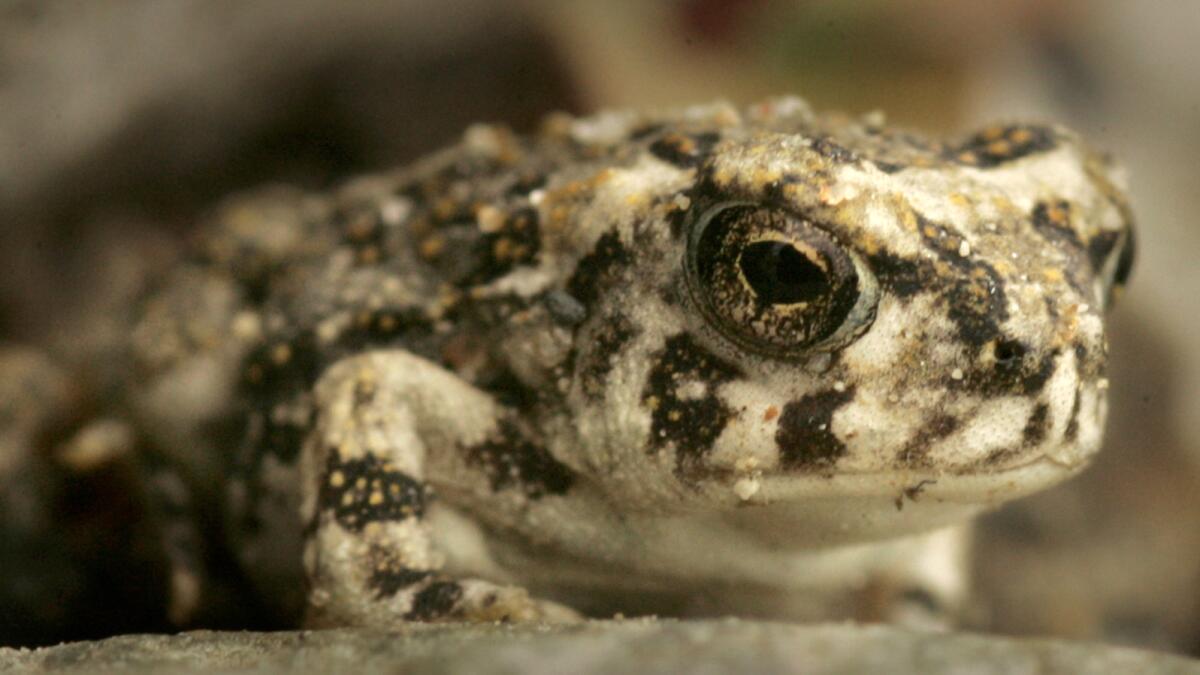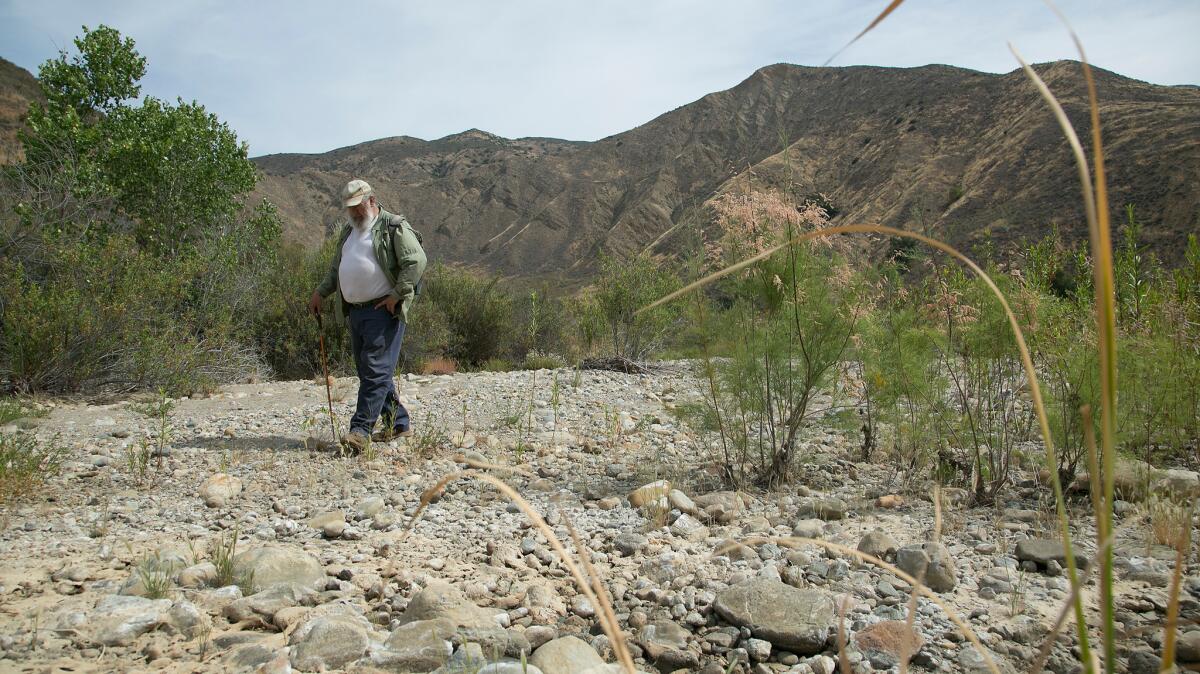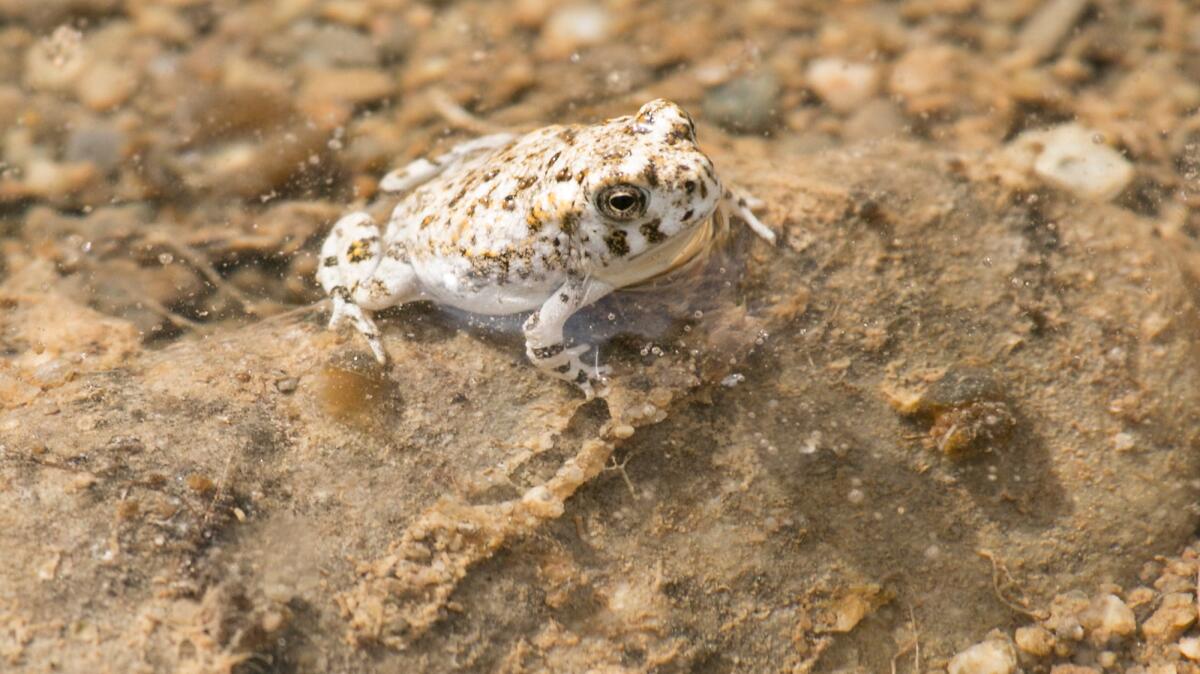Rare toads (presumably) love him; off-roaders do not

- Share via
Cantankerous outlaws and merciless nature are out to kill the arroyo toads of Santa Barbara and Ventura counties.
Like an ecological John Wayne, Sam Sweet — a big man with a beard and ponytail who at one point in his controversial career packed a .44 magnum — has spent his life trying to protect the warty, buff-colored amphibians.
Now 66, the UC Santa Barbara ecologist hiked recently along Agua Blanca Creek, a seven-mile tributary to Piru Creek in the southern Los Padres National Forest that is home to one of the 22 isolated populations of arroyo toads known to exist in California.
“They’re getting harder to find,” he said, methodically scanning the creek bed for a sign of the creatures that once numbered in the thousands.“ They’d be doing a lot better if not for the drought.”
This breeding season, which ended in May, and next year’s, he said, will be critical to the survival of the species with precise breeding requirements: slow-moving currents, periodic flooding, ants to feed on, and sandy shallows from which to belt out mating songs and lay eggs.
That’s because the arroyo toads’ lifespan is thought to be about five years. If the ongoing 5-year-drought, which included the driest four-year stretch recorded in California history, persists longer than six years, there could be too little water for the toads to reproduce, and their populations from Santa Barbara to Baja California could die out.
“If we lose any one of these places, there’s no way to bring it back,” said Sweet.

Some in the small world of people trying to save arroyo toads from extinction praise Sweet as the consummate conservation biologist.
“Sam’s field notes on arroyo toads and their habitat documented patterns of decline that supported its listing as an endangered species,” Greg Pauly, herpetologist at the Natural History Museum of Los Angeles County, said. “They’ll be useful for years to come because they also provide a rare continuity of data through time.”
Others portray him less flatteringly, as an advocate on a mission to save one species at the expense of others.
Travis Longcore, a spatial scientist at the University of Southern California in Los Angeles, tangled with Sweet in 2009.
Sweet wanted Pyramid Dam to release water into arroyo toad territory along Piru Creek during the summer months at rates low enough to prevent arroyo toad eggs from being washed away.
Longcore wanted flows that would benefit a variety of species including native trout.
Longcore describes Sweet as “a passionate old-school field conservationist” who is not inclined to compromise.
When Sam unloads, he unloads with both barrels, and I know that from having been on the receiving end.
— Travis Longcore, USC spacial scientist
“When Sam unloads, he unloads with both barrels,” Longcore said, “and I know that from having been on the receiving end.”
A native of Connecticut, in 1977 Sweet joined the UC Santa Barbara faculty, where he is a professor of evolution and ecology.
He began exploring the rugged Los Padres National Forest in the late 1970s, creating detailed records of reptile and amphibian distributions in habitat including the Sespe and Piru watersheds. “That’s when I discovered that the arroyo toad was in bad shape, and decided to try and make a difference.”
By the time the U.S. Fish and Wildlife Service declared the arroyo toad endangered in 1994, the species had lost more than 76% of its historic turf due to development, mining, agriculture, dam construction, predation by non-native species and drought.
That figure was largely based on Sweet’s field work in the early 1990s.
A lawsuit filed by the Center for Biological Diversity around the same time prompted closures of several campgrounds on U.S. Forest Service land along Sespe Creek, Piru Creek and the Santa Ynez River, where vehicle traffic had killed hundreds of adult arroyo toads.
Off-highway trails into creeks and riverbeds were also closed, and restrictions were imposed on gold mining during toad breeding season.
Kill All Toads
— Signs nailed to trees
Some critics expressed their anger over the restrictions by splintering U.S. Forest Service signs with gun fire, cutting through campground and trail head locks and gates with welding torches and decorating trees with posters reading: “Kill All Toads.”
“It was a strange, violent time and I started packing a .44 magnum for protection,” Sweet recalled.
“Some folks would ask if the gun was for bears. I’d say, nope.
‘Is it for rattlesnakes?’
‘Nope.’
‘Mountain lions?’
‘Nope.’
‘Then who’s it for?’
Jerks
— Sam Sweet, on why he carried a .44 magnum for a spell
‘Jerks.’ ”
“I only had to use it once,” he said. “A guy kept trying to run me over with a dirt bike. I finally put a shot over his head, which forced him to speed away.”
The struggle to secure maximum protection for the arroyo toad was far from over.
In 2014, after determining that conservation efforts had improved habitat and reduced threats, Fish and Wildlife proposed moving the amphibian down on its list, from “endangered” to “threatened.”
Environmental organizations led by the Center for Biological Diversity scoffed at the agency’s logic, pointing out that its own recovery plan criteria for “down listing” the species had not been met and that many threats remained.

Fearing that changing the toads’ status would “make it easy to reopen closed roads and campgrounds,” Sweet fired off a blunt critique to the agency, suggested its proposal was the product of “some political hack throwing the integrity of the USFWS into the sewage.”
The agency withdrew its proposal late last year.
As he continued along the creek recently, Sweet suddenly blurted, “Wait!”
He dropped to his knees at the edge of a shallow pool. A half-dozen pea-sized baby toads hopped along the bank. Sweet plopped one into the palm of his hand and lifted it triumphantly.
“Got one,” he said. “Anaxyrus californicus.”
Later, as Sweet emerged from the stream-side willows, a local rancher approached.
“See anything interesting out there today, Sam?”
“Well, arroyo toads aren’t dead yet,” Sweet said. “I counted six little guys in the creek — more than I’ve seen in recent years. I suspect they’ll be here a little while longer.”
Follow me @LouisSahagun
More to Read
Sign up for Essential California
The most important California stories and recommendations in your inbox every morning.
You may occasionally receive promotional content from the Los Angeles Times.











